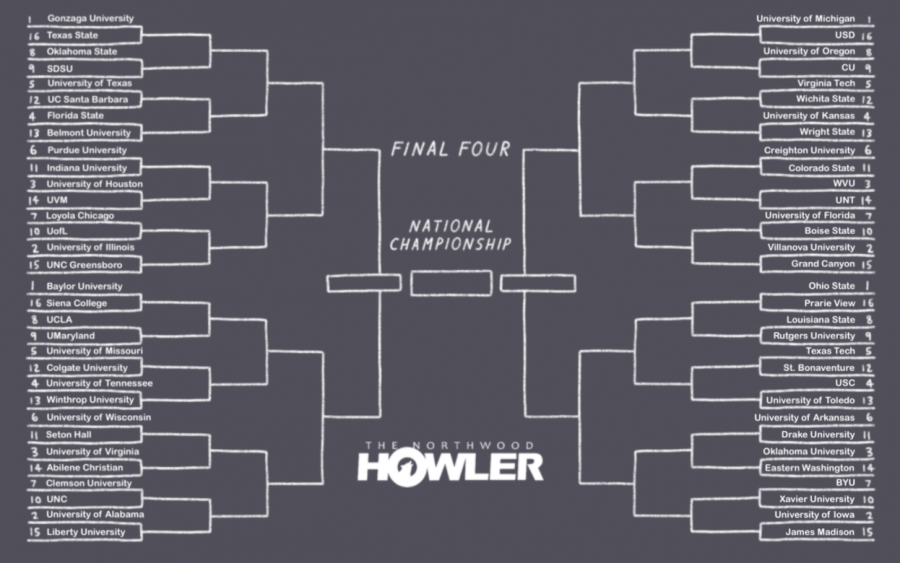March Madness: Field of 68
March 12, 2021
When it comes to postseason basketball, it doesn’t get any better than the NCAA’s March Madness. March Madness’ Selection Sunday, where the NCAA committee introduces the bracket for the tournament and signals in a period of anticipation for professional betters and casual fans, is set for tip-off on March 14. Ahead of the weekend’s festivities, The Howler takes its shot at cracking the infamous Field of 68 that usually stumps the best of us.
For each team, there are important rankings and records that come into play when the selection committee decides on the real bracket. These statistics include the NCAA Evaluation Tool (NET) and POM, a metric developed by basketball analyst Ken Pomeroy that predicts how teams will perform in the future. However, none of these statistics compare to the NCAA’s quadrant system, a tried and true method developed in the 2017-18 season. Essentially, the NCAA separates teams into tiers based on the difficulty of a team’s schedule. Quadrant one is for the “headline-grabbing” wins, quadrant two represents the “mediocre” wins, quadrant three shows the “bad” losses and quadrant four serves as the “easiest” games on the schedule. All of the quadrants are determined by comparing the team’s NET ranking to the opposing team’s and tallying up the team’s record in the quadrants. Now that we’ve set the stage, it’s action time.
No. 1 seeds
Gonzaga University (West Coast Conference): NET Rank: 1, POM Rank: 1, Quadrant One: 7-0, Quadrant Three and Quadrant Four: 10-0
Baylor University (Big 12 Conference): NET Rank: 2, POM Rank: 2, Quadrant One: 6-0, Quadrant Three and Quadrant Four: 9-0
University of Michigan (Big Ten Conference): NET Rank: 3, POM Rank: 3, Quadrant One: 11-0, Quadrant Three and Quadrant Four: 6-0
Ohio State University (Big Ten Conference): NET Rank: 7, POM Rank: 7, Quadrant One: 8-4, Quadrant Three and Quadrant Four: 7-0
Based on the statistics, it is evident why the top three teams—Gonzaga, Baylor and Michigan —are locked into the first seed: Each team backs up their first seed bids with perfect records. As for Ohio State, however, their seeding is not set in stone. After losing in thrillers to the University of Illinois and Michigan on Jan. 16 and Feb. 21, respectively, the Buckeyes could lose their position to the University of Alabama, who has the best chance at stealing the first seed title among the remaining teams. The Buckeyes had a rough time during the regular season, and that is mirrored in their 12 quadrant-one games, significantly more than any of their competitors, keeping them in the race for the first seed.
No. 2 seeds
University of Illinois (Big Ten Conference): NET Rank: 4, POM Rank: 5, Quadrant One: 7-5, Quadrant Three and Quadrant Four: 5-0
University of Alabama (Southeastern Conference): NET Rank: 8, POM Rank: 8, Quadrant One: 7-3, Quadrant Three and Quadrant Four: 6-0
Villanova University (Big East Conference): NET Rank: 10, POM Rank: 11, Quadrant One: 2-2, Quadrant Three and Quadrant Four: 8-0
University of Iowa (Big Ten Conference): NET Rank: 5, POM Rank: 4, Quadrant One: 4-5, Quadrant Three and Quadrant Four: 7-0
It’s too early to count Iowa out of the first seed race, but it’s a definite longshot. Struggling in their quadrant one games, with a sub .500 record, Iowa would need to win its games against the two-headed Big Ten beasts, Michigan and Ohio State. Additionally, Villanova is highly likely to drop to the third seed due to their easy schedule. Unless a miracle happens, three quadrant one wins will not cut it, but maybe it’s worth giving Villanova the benefit of the doubt.
No. 3 seeds
University of Houston (American Athletic Conference): NET Rank: 6, POM Rank: 6, Quadrant One: 2-1, Quadrant Three and Quadrant Four: 11-1
University of Virginia (Atlantic Coast Conference): NET Rank: 9, POM Rank: 9, Quadrant One: 3-4, Quadrant Three and Quadrant Four: 7-1
West Virginia University (Big 12 Conference): NET Rank: 15, POM Rank: 16, Quadrant One 6-6, Quadrant Three and Quadrant Four: 5-0
Oklahoma University (Big 12 Conference): NET Rank: 19, POM Rank: 26, Quadrant One: 5-5, Quadrant Three and Quadrant Four: 8-0
Oklahoma has been on a hot streak recently, winning seven of their last eight games, including road wins against top teams such as West Virginia and University of Texas. In the eyes of the selection committee, a late season surge for a March Madness berth doesn’t go unnoticed. West Virginia has had a similar path. With games against unranked opponents, Houston and Virginia should be set at the third seed, barring any unexpected turn of events.
No. 4 seeds
Florida State University (Atlantic Coast Conference): NET Rank: 12, POM Rank: 12, Quadrant One: 3-2, Quadrant Three and Quadrant Four: 5-1
University of Tennessee (Southeastern Conference): NET Rank: 18, POM Rank: 24, Quadrant One: 5-4, Quadrant Three and Quadrant Four: 9-0
University of Kansas (Big 12 Conference): NET Rank: 16, POM Rank: 22, Quadrant One: 5-7, Quadrant Three and Quadrant Four: 8-0
University of Southern California (Pac-12): NET Rank: 14, POM Rank: 14, Quadrant One: 3-1, Quadrant Three and Quadrant Four: 12-0
USC has made its presence felt in the eyes of the selection committee, as they have notched multiple mid-tier victories that will surely add up. On another note, after dominating the Big 12 for the past decades, Kansas has finally been pushed below its conference rivals. However, Kansas is not a team to be messed with, as legendary head coach Bill Self always has a trick up his sleeve. Florida State and Tennessee have been on the rise, so it would be a mistake to count them out of the race.
No. 5 seeds
University of Texas (Big 12 Conference): NET Rank: 23, POM Rank: 21, Quadrant One: 3-6, Quadrant Three and Quadrant Four: 7-0
University of Missouri (Southeastern Conference): NET Rank: 39, POM Rank: 44, Quadrant One: 6-4, Quadrant Three and Quadrant Four: 6-0
Virginia Tech (Atlantic Coast Conference): NET Rank: 36, POM Rank: 35, Quadrant One: 3-2, Quadrant Three and Quadrant Four: 8-0
Texas Tech (Big 12 Conference): NET Rank: 14, POM Rank: 22, Quadrant One: 4-7, Quadrant Three and Quadrant Four: 10-0
During the initial top four seed reveal, the selection committee penciled in Missouri as the 16th seed. However, since then, Missouri has been on a three game losing streak before their win against South Carolina. However, it isn’t all bad for Missouri, as player availability is a contributor in the bracket formation; starting center Jeremiah Tilmon missed all three games with injury. Not to mention, Missouri was the only team to hand Alabama a conference loss, keeping them in the mix for bracket seeding. Texas, Virginia and Texas Tech have seen their position remain stagnant, despite poor showings in their quadrant one games, leaving them with the fifth seed.
No. 6
Purdue University (Big Ten Conference), University of Wisconsin (Big Ten Conference), Creighton University (Big East Conference), University of Arkansas (Southeastern Conference)
No. 7
Clemson University (Athletic Coast Conference), Loyola Chicago (Missouri Valley Conference), University of Florida (Southeastern Conference), Brigham Young University (West Coast Conference)
No. 8
Oklahoma State University- tentative due to eligibility (Big 12 Conference), UCLA (Pacific-12 Conference), University of Oregon (Pacific-12 Conference), Louisiana State University (Southeastern Conference)
No. 9
San Diego State University (Mountain West Conference), University of Maryland (Big Ten Conference), University of Colorado (Pacific-12 Conference), Rutgers University (Big Ten Conference)
No. 10
University of Louisville (Atlantic Coast Conference), University of North Carolina (Atlantic Coast Conference), Boise State University (Mountain West Conference), Xavier University (Big East Conference)
No. 11
Indiana University (Big Ten Conference), Seton Hall University (Big East Conference), Colorado State University (Mountain West Conference), Drake University (Missouri Valley Conference)
No. 12
UC Santa Barbara (Big West Conference), Colgate University (Patriot League), Wichita State University (American Athletic Conference), St. Bonaventure University (Atlantic 10 Conference)
No. 13
Belmont University (Ohio Valley Conference), Winthrop University (Big South Conference), Wright State University (Horizon League Conference), University of Toledo (Mid-American Conference)
No. 14
University of Vermont (America East Conference), Abilene Christian University (Southland Conference), University of North Texas (Conference USA), Eastern Washington University (Big Sky Conference)
No. 15
University of North Carolina at Greensboro (Southern Conference), Liberty University (Atlantic Sun Conference), Grand Canyon University (Western Athletic Conference), James Madison University (Colonial Athletic Association Conference)
No. 16
Texas State University (Sun Belt Conference). Siena College (Metro Atlantic American Conference), South Dakota University (Summit League), Prairie View Agricultural and Mechanical University (Southwestern Athletic Conference)
First Four Out
Duke University (Atlantic Coast Conference), University of Connecticut (American Athletic Conference), University of Minnesota (Big Ten Conference), (American Athletic Conference), Saint Louis University (Atlantic 10 Conference)



![AAAAAND ANOTHER THING: [CENSORED] [REDACTED] [BABY SCREAMING] [SIRENS] [SILENCE].](https://thehowleronline.org/wp-content/uploads/2025/06/lucy-1200x800.jpg)





















































![AAAAAND ANOTHER THING: [CENSORED] [REDACTED] [BABY SCREAMING] [SIRENS] [SILENCE].](https://thehowleronline.org/wp-content/uploads/2025/06/lucy-300x200.jpg)